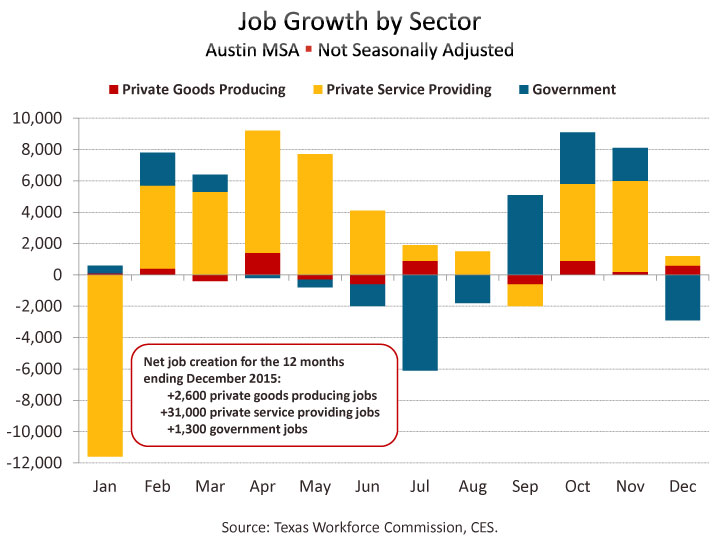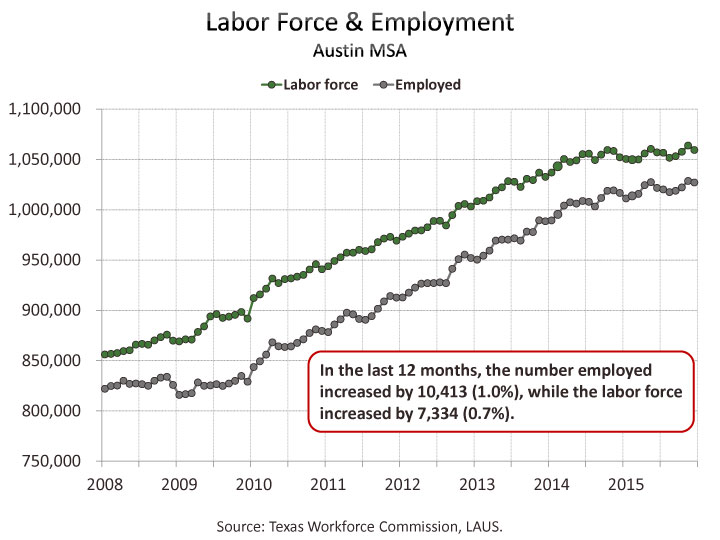Job Growth & Unemployment
Posted on 01/26/2016 by Beverly Kerr
-
Austin's seasonally adjusted unemployment rate is 3.2%, improved from 3.3% in November.
-
Austin added 34,900 net new jobs, or 3.8%, in the 12 months ending in December, making Austin the third fastest growing major metro.
-
Average annual job growth in Austin in 2015 appears to have been more moderate than the preceding few years. However, new updates to an alternative jobs series hint at more robust growth. Benchmark revisions due in March might ultimately boost the year’s relative performance.
The Austin metropolitan area added 34,900 net new jobs, or 3.8%, in the 12 months ending in December, according to Friday’s release of preliminary payroll jobs numbers by the Texas Workforce Commission (TWC) and the U.S. Bureau of Labor Statistics (BLS). Austin’s 3.8% growth makes it the third best performing among the 50 largest metro areas. Dallas and San Antonio followed Austin at sixth and seventh fastest growing. The other two major Texas metros missed the top 10. Fort Worth grew by 1.5% (39th), and Houston grew by 0.8% (46th) between December 2014 and December 2015.

Based on annual averages of monthly nonfarm payroll jobs estimates, Austin saw more moderate growth in 2015, 3.3%, compared to the preceding few years. Growth was 4.0% or more in 2012, 2013, and 2014. Benchmark revisions, impacting the last several years of these Current Employment Statistics (CES) estimates, will come out in late March. A second set of data updated last week by the TWC were job estimates, through the third quarter, from a program called the Quarterly Census of Employment and Wages (QCEW). QCEW is a key input to the annual benchmark revision of the CES sample survey estimates. QCEW’s version of job estimates for the Austin metro show 4.5% growth in 2015 over 2014, based on the first three quarters. That is afaster rate of growth than QCEW shows for Austin in three preceding years. While there are some differences in the universes of coverage of the two datasets,** it could be advisable to suspend judgement on 2015 until the arrival of March’s revisions.
For the year ending in December, private sector job growth in the Austin MSA is 4.4%, or 33,600 jobs, and with all private industry divisions, but manufacturing, contributing to the growth. Austin's sizable government sector (nearly 19% of jobs) saw modest growth over the last 12 months, gaining 1,300 jobs or 0.8%, thus bringing the overall job growth rate to 3.8%.

Texas saw weaker net private sector job growth of 1.4% with all private industries, except two, adding jobs over the last 12 months. Since the government sector, which accounts for over 16% of total state employment, also gained 1.4%, total job growth statewide is 1.4%. For the nation, private sector growth is 2.2% for the 12 months ending in December, with all private industries adding jobs. Overall job growth is a more modest 1.9% because the government sector gained only 0.5%.

Jobs in December are down from the preceding month by 1,700 jobs or 0.2% in the not-seasonally-adjusted series for Austin, while on a seasonally adjusted basis, jobs are down by 500 or 0.1%. Seasonally adjusted jobs are also down in Dallas and in San Antonio by 0.2%. Jobs are up in Houston by 0.2% and in Fort Worth by 0.6%. Statewide, seasonally adjusted jobs are up 24,900 or 0.2%. Nationally, seasonally adjusted jobs rose 0.2% in December.

In Austin, the industry adding the most jobs and growing fastest is professional and business services which grew by 13,200 jobs, or 8.7%, over the last 12 months. Construction and natural resources grew 8.3% and added 4,200 jobs. Also growing at faster-than-average rates are leisure and hospitality (7.7% or 8,100 jobs) and wholesale trade (4.5% or 2,100 jobs). Jobs in manufacturing fell by 2.8% or 1,600 jobs.

Statewide, leisure and hospitality grew fastest at 4.6% (54,600 jobs). Education and health services added the most jobs 68,800 (4.4%). The other relatively fast growing industries were professional and business services (2.8%), information (1.8%), and retail trade (1.6%). Manufacturing declined by 41,700 jobs (-4.7%) and construction and natural resources declined by 26,600 jobs (-2.7%). The contraction of the latter sector was driven by mining, quarrying, and oil and gas extraction (down 33,700 jobs or 11.1%). The construction industry added jobs (7,100 or 1.1%).
Nationally, professional and business services grew fastest, adding 3.1% over the 12 months ending in December. Education and health services and leisure and hospitality and also grew at faster-than-average rates, 3.0% and 2.9% respectively. Manufacturing saw the lowest rate of growth, 0.3%. No industry lost jobs.

The net gain for private service-providing industries in Austin is 31,000 jobs, or 4.8%, over the last 12 months. Employment in goods producing industries is up by 2,600 jobs or 2.4%. Statewide, private service-providing industries are up 211,100 or 2.6%, but goods producing industries are down 68,300 jobs or -3.6%.
We also now have December labor force, employment, and unemployment numbers for Texas and local areas in Texas. The same data for all U.S. metros that we often do a ranking of will not be released until February 3. In November, Austin had the third lowest rate of unemployment among the 50 largest metros.

Unemployment numbers for December show Austin’s performance relative to the state and other major Texas metros being sustained. In December, Austin is at 3.1%, while the other major metros range from 3.5% in San Antonio to 4.6% in Houston. Dallas and Fort Worth are at 3.6% and 3.8% respectively. Austin’s rate one year ago was 3.4%. The rates in Texas’ other major metros are 0.2 to 0.4 percentage points improved on the rates seen a year ago, except for Houston, which has seen its unemployment rate increase (from 4.0%). The statewide not-seasonally-adjusted rate is now 4.2%, up from 4.1% in December of last year. The December national rate is 4.8% compared to 5.4% a year ago.
In 2007, before the impact of the Great Recession, unemployment averaged 3.6% in Austin, 4.3% in Texas, and 4.6% nationally. Based on average rates for 2015, unemployment is lower in Austin (3.3%) than before the recession. Texas’ unemployment averaged 4.3% in 2015, the same as 2007, while the nation, with unemployment averaging 5.3%, has a wider gap to bridge in regaining its pre-recession level of unemployment.
Within the Austin MSA, Travis County has the lowest unemployment rate in December, at 3.0%, while Caldwell County has the highest at 4.0%. The rate is 3.1% in Williamson and Hays Counties and 3.5% in Bastrop County.

On a seasonally adjusted basis, Austin’s December unemployment rate is 3.2%, improved from 3.3% in November. Rates have been 3.3% or lower since April. Austin has not seen unemployment this low since early 2001, before the “dot-com” recession. The statewide rate is 4.7%, up from 4.6% in November. Nationally, the seasonally adjusted unemployment rate is 5.0%, unchanged from November.
San Antonio has the next lowest seasonally adjusted rate at 3.7%, while Dallas, Fort Worth, and Houston are at 3.0%, 4.0% and 4.7% respectively. December rates are down by 0.1 from November in Dallas, Houston and San Antonio and 0.2 in Fort Worth. Seasonally adjusted unemployment rates for Texas metros are produced by the Federal Reserve Bank of Dallas. (The TWC also produces seasonally adjusted rates for Texas metros, but publication lags the Dallas Fed’s data.)

With Austin’s unemployment rate down from one year ago, the number unemployed has also declined. In December 2014, Austin’s number of unemployed was 35,414. Over the last 12 months, the unemployed have decreased by 3,079 or 8.7%, to 32,335. The number of unemployed in Austin averaged more than 60,000 for three years running during the Great Recession.

The Austin metro’s civilian labor force (employed plus unemployed) has increased by 0.7% or 7,334 persons from one year age, while persons employed increased by 1.0% or 10,413. Texas saw negative growth of 0.6% in labor force and 0.7% in employed, while the number unemployed increased by 2.8%. Nationally, December civilian labor force is up by 1.1%, while employed is above the level of a year ago by 1.7%, and 789,000 fewer people (9.5%) are unemployed.
Texas Workforce Commission will release January estimates on March 4.
** QCEW is based on administrative records for workers covered by state and federal unemployment insurance. CES estimates include these workers as well as supplemental estimates for some industries that have workers that are not covered by unemployment insurance.
The Chamber’s Economic Indicators page provides up-to-date historical spreadsheet versions of Austin, Texas and U.S. data for both the Current Employment Statistics (CES) and Local Area Unemployment Statistics (LAUS) data addressed above.
Related Categories: Central Texas Economy in Perspective